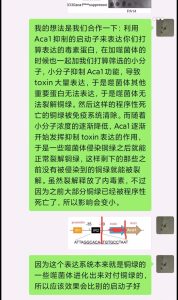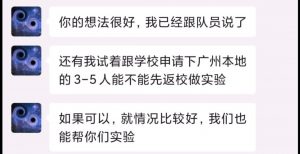We joined in Anti-Biofilm Community (ABC) on Aug 31st, 2020. Anti-Biofilm Community is a cloud community where iGEMers can share their idea about biofilm. Many teams joined in Anti-Biofilm Community, including WHU_China, SUSTech_Shenzhen, UM_Macau, HK_HCY, Tsinghua, and DUT_China. We always discussed problems on biofilm in the WeChat group of ABC, such as the measurement of some parameters about biofilm. Also, SUSTech_Shenzhen joined an online meetup of ABC on Sep 2nd, 2020 to share our opinion on biofilm quantification with other teams.
Partnership
Collaboration with Teams in Anti-Biofilm Community
Apart from online discussion, numbers in ABC collaborated in education. We printed a brochure to introduce team projects and science stories of synthetic biology to the public so that the public could gain more understanding of synthetic biology and iGEM. In this brochure, there are two parts. In the first part, every team made a brief self-introduction. We talked about what the aim of our projects was, how our project was developed and how our projects could be applied in the real world. In the second part, we introduced some scientific knowledge related to our project. As our team, SUSTech_Shenzhen wanted to solve some problems on the application of Pseudomonas with an anti-CRISPR-Cas system, we briefly introduced what the CRISPR-Cas system was and in what way Pseudomonas is important in bioremediation.
Figure 1. Contents of our brochure
Figure 2. Project introduction of Team SUSTech_Shenzhen
(At that time, we took advice of Shengchun WU and decided to apply our project in the field of biosynthesis)
Figure 3. Science story of Team SUSTech_Shenzhen
Collaboration with Team SCUT_China
As Team SCUT_China and we both focus on the interaction between Pseudomonas and bacteriophage specific to Pseudomonas, we communicated a lot to share our opinions on experiment design related to Pseudomonas. Under epidemic Convid-19, our communication stayed online and our plan of holding a meetup between the two failed.
Then, we proposed a possible way to apply our Aca1 inhibitor in their project to control the lysogenic cycle of bacteriophage so that they can reduce the interference caused by a failure in lysis of Pseudomonas (Figure 4 & 5). Such an experiment was planned to be carried out in the experiment of Team SCUT_China. For us, they offered a laboratory for the processing of phages as we did not have a professional laboratory to carry out phage experiments (Figure 5). In this way, both of us could benefit from each other.
However, due to Convid-19, both of our experiment plans were delayed and we failed to test the feasibility of our idea. Nevertheless, both of the two teams did share much about the bacteriophage infection specific to Pseudomonas and learn a lot from each other.
Figure 4. Proposing a collaboration plan to SCUT_China
[Translation: My idea is that we can have cooperation: you can use acr-related promoter to express the toxin protein that you intend to express, and add phage and the small molecule we are screening for at the same time. Such small molecule can inhibit Aca1, causing a large-scale expression of toxin, therefore, other important phage protein cannot be expressed and phage fails to lyse Pseudomonas. After Pseudomonas suffers apoptosis, debris is removed by the immune system. As the concentration of small molecule decreases, Aca1 gradually begin to inhibit toxin expression. Therefore, some phage infection can induce lysis of Pseudomonas, and the resting Pseudomonas that was not infected in the previous process finally is lysed. Although lysis of Pseudomonas releases endotoxin, most Pseudomonas has gone through programmed cell death and its effect will be minimized.]
Figure 5. Feedback from SCUT_China about our idea
[Main points: they express their agreement on our idea, tell us that they are asking for permission to do an experiment in school, and if possible, they would like to have a try on our idea]






